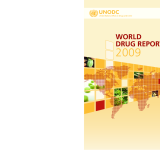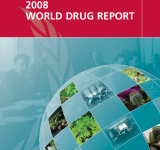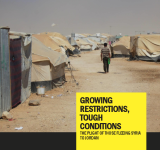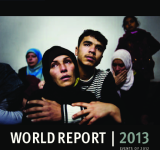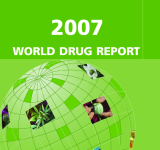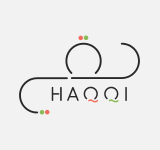Europe
The World Drug Report presents comprehensive information on the illicit drug situation. It provides detailed estimates and trends on production;; trafficking and consumption in the opium/heroin;; coca/cocaine;; cannabis and amphetamine-type stimulants markets. The drug problem is being contained but there are warning signs that the stabilisation which has occurred over the last few years could be in danger. Notable amongst these is the increase in both opium poppy and coca cultivation in 2007;;some growth in consumption in developing countries and some development of new trafficking patterns. There have also been encouraging contractions in some of the main consumer markets. This year;; almost one hundred years since the Shanghai Opium Commission in 1909;; the Report presents an historical review of the development of the international drug control system.
يستند مضمون هذا التقرير المتعلق بالأردن إلى حد كبير إلى زيارة بحثية قامت بها منظمة العفو الدولية إلى البلاد في يونيو/حزيران 2013. وقد التقى وفد المنظمة بممثلي السلطات الأردنية ووكالات الأمم المتحدة والوكالات الإنسانية الدولية والمنظمات غير الحكومية والجمعيات الخيرية;; فضلاً عن أكثر من 150 لاجئاً من سوريا في مجتمعات اللجوء والمجتمعات المضيفة. ونشرت منظمة العفو الدولية هذا التقرير بهدف لفت الانتباه إلى الصعوبات التي يواجهها الفارون من سوريا طلباً للسلامة. وفي الوقت الذي يركز فيه التقرير بشكل رئييس على الأوضاع في الأردن;; فإنه يتضمن تحديثا للمعلومات التي كانت المنظمة قد نشرتها في السابق بشأن التحديات التي يواجهها اللالجئون من سوريا في البلدان المجاورة. وقد أمعنت منظمة العفو الدولية النظر في التحديات التي يواجهها اللاجئون في الأردن;; ولا سيما أولئك الذين يقطنون في مخيم الزعتري;; وهو أضخم مخيمات اللاجئين من سوريا في الأردن. وأجرت المنظمة تحقيقاً حول معاناة اللاجئين;; ليس من ظروف المعيشة القاسية في الصحراء فحسب;; وإنما أيضاً من ارتفاع معدلات الجريمة وغيرها من المخاوف الأمنية.
This 23rd annual World Report summarizes human rights conditions in more than 90 countries and territories worldwide in 2012. It reflects extensive investigative work that Human Rights Watch staff has undertaken during the year;; often in close partnership with domestic human rights activists.
The World Drug Report presents the most comprehensive statistical view of today's illicit drug situation. This year's edition reports signs of long-term containment of the global problem. However;; the overall trend masks contrasting regional situations;; which the report examines in detail. For instance;; while an impressive multi-year reduction in opium poppy cultivation continued in South-East Asia;; Afghanistan recorded a large increase in 2006. More interceptions of cocaine and heroin shipments across the world have played an important part in stabilizing the market. However;; as we witness successes in some areas;; challenges appear in others. Although drug abuse levels are stabilizing globally;; countries along major and new trafficking routes;; such as those now going through Africa;; may face increasing levels of drug consumption. The World Drug Report 2007 also discusses a possible method to better assess and monitor the role played by organized crime in transnational drug trafficking.
Some 200 million people;; or 5 percent of the global population age 15-64;; have used illicit drugs at least once in the last 12 months. Among this population are people from almost every country on earth. More people are involved in the production and trafficking of illicit drugs and still more are touched by the devastating social and economic costs of this problem. Partially a consequence of its pervasiveness and partially a consequence of the illicit and hidden nature of the problem;; reliable analysis and statistics on the production;; trafficking and use of illicit drugs are rare. The World Drug Report 2006 endeavours to fill this gap. It provides one of the most comprehensive overviews of illicit drug trends at the international level. In addition;; it presents a special thematic chapter on cannabis;; by far the most widely produced;; trafficked and used drug in the world. The analysis of trends;; some going back 10 years or more;; is presented in Volume 1. Detailed statistics are presented in Volume 2. Taken together;; these volumes provide the most up-to-date view of today's illicit drug situation.
The negative impacts of the illicit drug trade touch every society in the world. This year's World Drug Report estimates that 200 million people;; or 5% of the global population age 15-64;; have consumed illicit drugs at least once in the last 12 months. The drug trade is pernicious and large. UNODC estimates its retail value at US$ 321bn. It impacts almost every level of human security from individual health;; to safety and social welfare. Its consequences are especially devastating for countries with limited resources available to fight against it. The World Drug Report 2005 provides one of the most comprehensive overviews of illicit drug trends at the international level. In addition;; this year it presents the work of UNODC in two new areas of research. Both aim to provide tools to enrich our understanding of an immensely complex situation: an estimate of the financial value of the world drug market;; and the preliminary steps towards the creation of an illicit drug index. The analysis of trends;; some going back 10 years or more;; is presented in Volume 1. Detailed statistics are presented in Volume 2. Taken together these volumes provide the most up to date view of today's illicit drug situation.
An estimated 3 % of the global population;; or 185 million people consume illicit drugs annually. Among this population are people from almost every country on earth and from every walk of life. Countless more people;; around the world;; are involved in the production and trafficking of illicit drugs;; and still more are touched by the devastating social and economic costs of this trade. These people live in both developed and developing countries;; are rich and poor;; healthy and unhealthy;; citizens and refugees. Illicit drugs are a truly global phenomenon. Partially a consequence of this pervasiveness;; and partially a consequence of the illicit and hidden nature of this trade;; reliable analysis and statistics on the production;; trafficking and consumption of illicit drugs are rare. In cooperation with Member States;; the United Nations Office on Drugs and Crime (UNODC) has endeavoured to fill the gaps. In this first edition of the new two volume World Drug Report;; UNODC presents more quantitative data than ever before in an effort to increase the amount of factual evidence available in a field which is so notoriously difficult to quantify. This year;; the analysis of trends;; some going back ten years or more;; is presented in Volume 1. Detailed statistics are presented in Volume 2. Taken together these volumes will provide the most complete picture yet on today's illicit drug situation.
